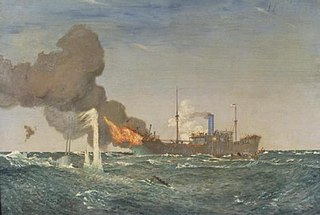
HMS Dunraven was a Q-Ship of the Royal Navy during World War I.
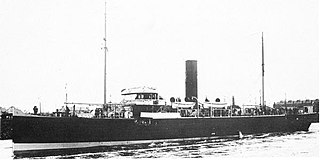
Q-ships, also known as Q-boats, decoy vessels, special service ships, or mystery ships, were heavily armed merchant ships with concealed weaponry, designed to lure submarines into making surface attacks. This gave Q-ships the chance to open fire and sink them.

The Royal Naval Reserve (RNR) is one of the two volunteer reserve forces of the Royal Navy in the United Kingdom. Together with the Royal Marines Reserve, they form the Maritime Reserve. The present RNR was formed by merging the original Royal Naval Reserve, created in 1859, and the Royal Naval Volunteer Reserve (RNVR), created in 1903. The Royal Naval Reserve has seen action in World War I, World War II, the Iraq War and the War in Afghanistan.

Ian Edward Fraser, was an English diving pioneer, sailor and recipient of the Victoria Cross, the highest award for gallantry in the face of the enemy that can be awarded to British and Commonwealth forces. Fraser was born in Ealing in Middlesex and went to school in High Wycombe. After initially working on merchant ships and serving in the Royal Naval Reserve, he joined the Royal Navy at the start of the Second World War. After being awarded the Distinguished Service Cross for actions while serving on submarines, he was placed in command of a midget submarine during an attack in Singapore codenamed Operation Struggle. For his bravery in navigating the mined waters, and successfully placing mines on a Japanese cruiser, Fraser was awarded the Victoria Cross.
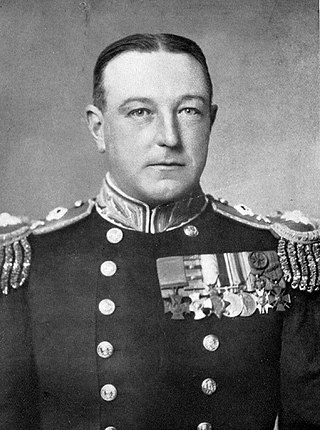
Vice-Admiral Gordon Campbell, was a British naval officer, writer, politician and a recipient of the Victoria Cross, the highest award for gallantry in the face of the enemy that can be awarded to British and Commonwealth forces. He was also awarded the Croix de Guerre and appointed a chevalier of the Légion d'honneur for his actions during the First World War.
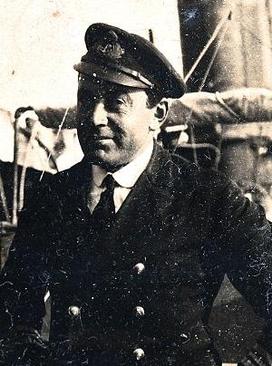
Geoffrey Saxton White VC was an English Royal Navy officer and recipient of the Victoria Cross, the highest and most prestigious award for gallantry in the face of the enemy that can be awarded to British and Commonwealth forces.

William Williams VC, DSM & Bar, was a Welsh recipient of the Victoria Cross, the highest and most prestigious award for gallantry in the face of the enemy that can be awarded to a member of the British and Commonwealth armed forces.

William Edward Sanders was a First World War New Zealand recipient of the Victoria Cross (VC), the highest award for gallantry "in the face of the enemy" that could be awarded to British and Commonwealth forces at the time.

Captain Richard Been Stannard, was a British sailor, officer in the Royal Naval Reserve (RNR), and a recipient of the Victoria Cross (VC), the highest award for gallantry in the face of the enemy that can be awarded to British and Commonwealth forces. Stannard was awarded the first VC to the RNR in the Second World War.

Commander Donald Cameron, VC was a Scottish sailor and a recipient of the Victoria Cross, the highest award for gallantry in the face of the enemy that can be awarded to British and Commonwealth forces. He is one of three VC recipients from the small town of Carluke in South Lanarkshire. The Rotary Club of Carluke have erected a millennium stone in the town market place to commemorate this.
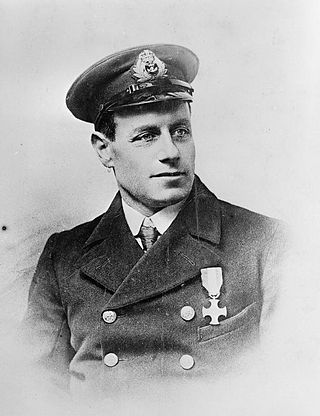
Thomas Crisp VC, DSC, RNR was an English sailor and posthumous recipient of the Victoria Cross. Crisp, in civilian life a commercial fisherman operating from Lowestoft in Suffolk, earned his award after being killed during the defence of his vessel, the armed naval smack Nelson, in the North Sea against an attack from a German submarine in 1917.

Chief Petty Officer Ernest Herbert Pitcher was a Royal Navy (RN) sailor and an English recipient of the Victoria Cross (VC), the highest award for gallantry in the face of the enemy that can be awarded to British and Commonwealth forces.

Rear Admiral Eric Gascoigne Robinson was a Royal Navy officer and a recipient of the Victoria Cross. He earned his award by going ashore and single-handedly destroying a Turkish naval gun battery while a lieutenant commander with the fleet stationed off the Dardanelles during the Gallipoli campaign in the First World War.

Rear Admiral Basil Charles Godfrey Place,, known as Godfrey Place, was an officer in the Royal Navy and a recipient of the Victoria Cross, the highest award for gallantry in the face of the enemy that can be awarded to British and Commonwealth forces.
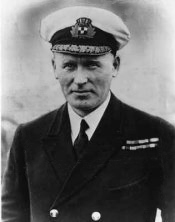
Ronald Niel Stuart, VC, DSO, RD, RNR was a British Merchant Navy commodore and Royal Navy captain who was highly commended following extensive and distinguished service at sea over a period of more than thirty-five years. During World War I he was awarded the Victoria Cross, the Distinguished Service Order, the French Croix de Guerre avec Palmes and the United States' Navy Cross for a series of daring operations he conducted while serving in the Royal Navy against the German U-boat campaign in the Atlantic.

Coastal Motor Boat was a small high-speed British torpedo boat used by the Royal Navy in the First World War and up to end of the Second World War.
HMS Farnborough, also known as (Q-5), was a Q-ship of the British Royal Navy that saw service in the First World War. Farnborough was a heavily armed merchant ship with concealed weaponry that was designed to lure submarines into making surface attacks. Farnborough sank two submarines in her service in the First World War. The first submarine was SM U-68 which involved the first successful use of depth charges. The second submarine was SM U-83, which was sunk on 17 February 1917 in an action for which Captain Gordon Campbell of Farnborough received the Victoria Cross. HMS Farnborough was severely damaged in the action and was beached the same day.

Result is a three-masted cargo schooner built in Carrickfergus in 1893. She was a working ship until 1967, and served for a short time in the Royal Navy as a Q-ship during World War I. She currently rests on land at the Ulster Folk and Transport Museum, and in 1996 was added to the National Register of Historic Vessels.

HMS Prize was a schooner converted to a Q ship during the First World War and commanded by Lieutenant William Sanders of the Royal Naval Reserve.
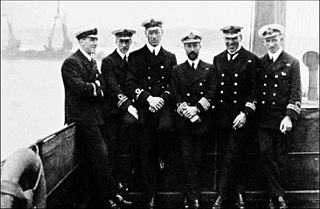
Captain Cedric Naylor was a Royal Navy officer of the First and Second World Wars. Naylor was a merchant seaman before joining the Royal Naval Reserve on the outbreak of the First World War. In November 1915 he was posted as first lieutenant to HMS Penshurst, a Q-ship, a warship disguised as a merchant vessel intended to fool German U-boats into surfacing so they could be sunk. Naylor received the Distinguished Service Cross for his part in the sinking of SM UB-19 on 30 November 1916 and a bar for further operations in February and March 1917. Naylor was granted temporary command of Penshurst after its captain was incapacitated in June and the next month damaged a submarine, for which he was awarded the Distinguished Service Order. Further distinguished service in the following months saw him receive a bar to the medal and a transfer to the Royal Navy. Naylor was hunting for SM U-110 on Christmas Eve 1917 and Penshurst was struck by a torpedo fired by the submarine. Despite suffering heavy damage Naylor remained onboard with two gun crews, hoping the U-boat would surface to finish off the ship. When U-110 surfaced it was hit twice and damaged before Penshurst sank. Naylor survived and was awarded a second bar to his DSO. He commanded the sloop Polyanthus for the remainder of the war.




















